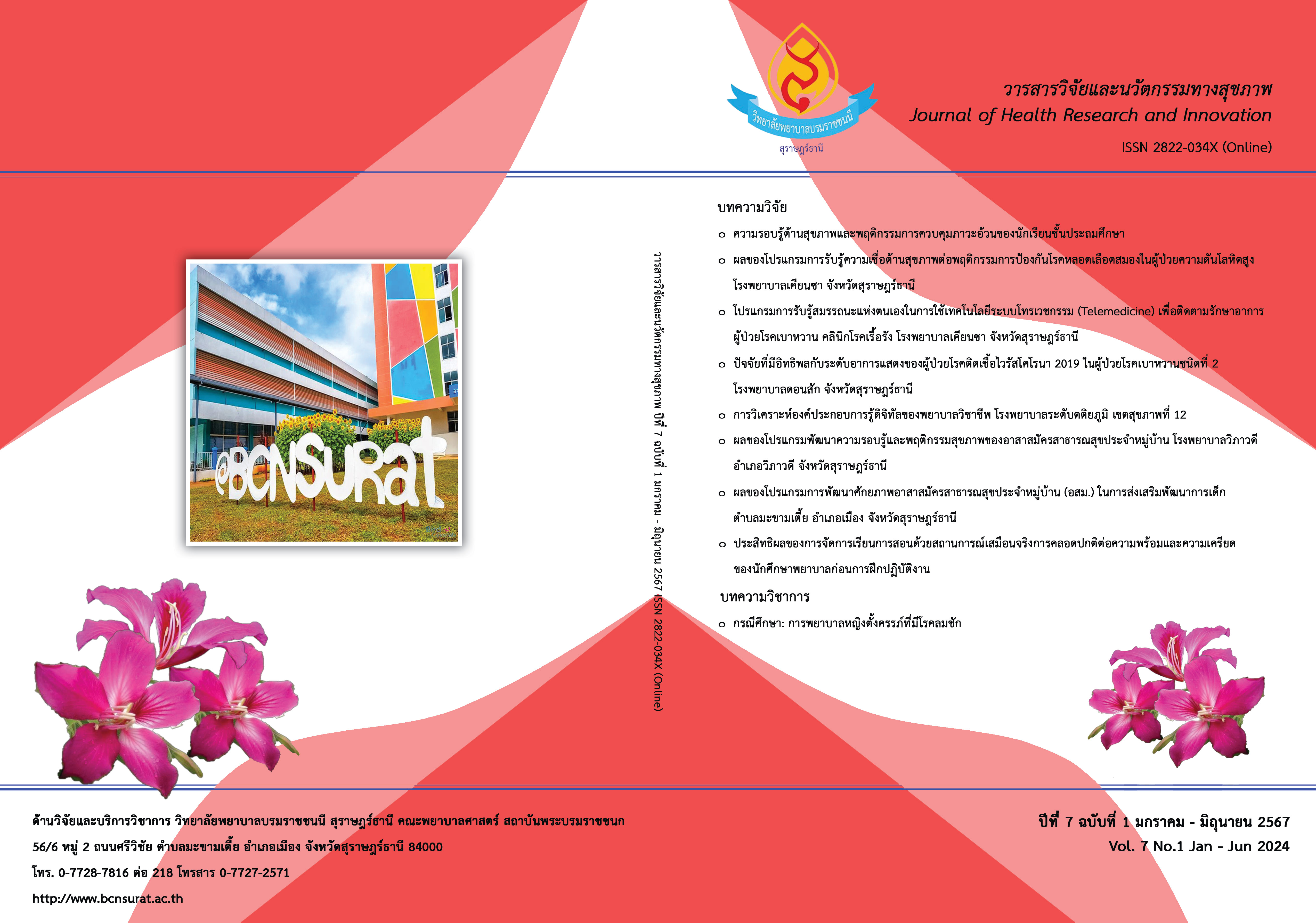ปัจจัยที่มีอิทธิพลกับระดับอาการแสดงของผู้ป่วยโรคติดเชื้อไวรัสโคโรนา 2019 ในผู้ป่วยโรคเบาหวานชนิดที่ 2 โรงพยาบาลดอนสัก จังหวัดสุราษฎร์ธานี
คำสำคัญ:
ปัจจัยที่มีอิทธิพล, ระดับอาการแสดงของโรคติดเชื้อไวรัสโคโรนา 2019, ผู้ป่วยโรคเบาหวานบทคัดย่อ
การศึกษาวิจัยนี้ มีวัตถุประสงค์เพื่อศึกษาอิทธิพลของปัจจัยส่วนบุคคลและปัจจัยด้านคลินิกกับระดับอาการแสดงของโรคติดเชื้อไวรัสโคโรนา 2019 ของผู้ป่วยโรคเบาหวานชนิดที่ 2 เป็นการศึกษาเชิงวิเคราะห์โดยศึกษาข้อมูลย้อนหลัง กลุ่มตัวอย่างคือ ผู้ป่วยโรคเบาหวานชนิดที่ 2 ที่มีการติดเชื้อไวรัสโคโรนา 2019 จำนวน 222 คน คำนวณโดยสูตรยามาเน เครื่องมือที่ใช้แบ่งออกเป็น 3 ส่วน ได้แก่ แบบบันทึกข้อมูลส่วนบุคคล แบบบันทึกข้อมูลปัจจัยด้านคลินิก และแบบบันทึกระดับอาการแสดงของโรค ผ่านตรวจสอบความตรงเชิงเนื้อหาจากผู้ทรงคุณวุฒิจำนวน 3 ท่าน ได้ค่าดัชนีความสอดคล้อง .66-1.00 วิเคราะห์ข้อมูลด้วยสถิติเชิงพรรณนา และสถิติวิเคราะห์สมการถดถอยพหุคูณแบบเป็นขั้นตอน
ผลการวิจัยพบว่า ระดับอาการแสดงของโรคไวรัสโคโรนา 2019 ในผู้ป่วยโรคเบาหวานชนิดที่ 2 โรงพยาบาลดอนสักอยู่ในระดับเล็กน้อย (Mean=2.32, SD.= .75) ปัจจัยส่วนบุคคลและปัจจัยด้านคลินิกสามารถร่วมทำนายอาการแสดงของโรคติดเชื้อไวรัสโคโรนา 2019 ในผู้ป่วยเบาหวานชนิดที่ 2 ได้ร้อยละ 31.5 (R2=0.315, F=13.78) อย่างมีนัยสำคัญทางสถิติ (p<.05) และเมื่อพิจารณาตัวแปรย่อยปัจจัยส่วนบุคคล พบว่าตัวแปรย่อยที่มีอิทธิพลต่ออาการแสดงของโรคติดเชื้อไวรัสโคโรนา 2019 ในผู้ป่วยโรคเบาหวานชนิดที่ 2 ได้แก่ ดัชนีมวลกาย (β= .40, t=5.68, p<.01) อายุ (β= .29, t=3.72, p<.01) การได้รับวัคซีน Covid-19 (β= -.22, t=-3.36, p<.01) และจำนวนปีที่ป่วยด้วยโรคเบาหวานชนิดที่ 2 (β= .16, t=2.23, p<.01) ส่วนตัวแปรย่อยปัจจัยด้านคลินิกพบว่าระดับน้ำตาลสะสมมีอิทธิพลต่ออาการแสดงของโรคติดเชื้อไวรัสโคโรนา 2019 ในผู้ป่วยเบาหวานชนิดที่ 2 (β= .29, t= 3.72, p<.01) ดังนั้น โรงพยาบาลชุมชนควรนำปัจจัยที่มีอิทธิพลกับอาการแสดงของโรคติดเชื้อไวรัสโคโรนา 2019 ในผู้ป่วยโรคเบาหวานชนิดที่ 2 คือ ดัชนีมวลกายของผู้ป่วย อายุ ระดับน้ำตาลสะสม การได้รับวัคซีน Covid-19 และจำนวนปีที่ป่วยด้วยโรคเบาหวานชนิดที่ 2 มาสร้างแนวปฏิบัติในการดูแลผู้ป่วยโรคเบาหวานชนิดที่ 2 ที่ติดเชื้อไวรัสโคโรนา 2019 เพื่อไม่ให้ผู้ป่วยมีระดับอาการแสดงที่รุนแรงมากขึ้น
เอกสารอ้างอิง
Chee YJ, Tan SK, Yeoh E. (2020). Dissecting the interaction between COVID-19 and diabetes mellitus. Journal of diabetes investigation, 11(5), 1104-14.
Department of Medical Services, Ministry of Public Health. (2022). Guidelines for medical practice, diagnosis, care, and prevention of infection Hospital germs in the case of coronavirus disease 2019 (COVID-19), 2nd revised edition, April 22, 2022. (In Thai)
Faghir-Gangi, M., Moameri, H, Abdolmohamadi, N, & Nematollahi SH. (2020). The prevalence of type 2 diabetes in patients with COVID 19: a systematic review and meta-analysis. Via Medica, 9(5), 271–278.
International Diabetes Federation.(2021) IDF Diabetes Atlas, 10th ed. Brussels, Belgium: International Diabetes Federation, 2021.
Jindadee, S., Suwannarat, S., & Kankang, O. (2022). Factors related to the level of symptoms of Coronavirus 2019 patients at Khao Saming Hospital, Trat Province. Retrieved April 13, 2022, from https://trathospital.go.th/KM/TempDoc/temp_460.pdf (In Thai)
Jirasiriruk, S. (2023). The Association Between HbA1c and Severity of COVID-19 Patients in Nakhonpathom Hospitalin Nakhonpathom Hospital. Region 4-5 Medical Journal, 42(3), 407-415. (In Thai)
Jones R. at all. (2021). Risk Predictors and Symptom Features of Long COVID Within a Broad Primary Care Patient Population Including Both Tested and Untested Patients. Pragmatic and Observational Research, 12, 93-104.
Outbreak: guidance for people with diabetes, International Diabetes Federation, Retrieved April 25, 2022, from https://idf.org/europe/news/covid-19-outbreak- guidance-for-people-with-diabetes
Pankluab, B. (2020). Factor Associated with Covid-19 Patient’s Symptoms in Phuket’s Community Hospita. Retrieved September 22, 2022, from www.vachiraphuket.go.th (In Thai)
Parohan M., Yaghoubi S., Seraji A., Javanbakht MH., Sarraf P., Djalali M.(2021). Risk factors for mortality in patients with Coronavirus disease 2019 (COVID-19) infection: a systematic review and meta-analysis of observational studies. Aging Male, 23(5), 1416-24.
Pooy A.A. (2021). Risk Factors Associated with Long COVID Syndrome: A Retrospective Study., Iranian Journal of Medical Sciences, 46(6), 428-436.
Sharif N., Alzahrani KJ., Ahmed SN., Dey SK. (2021). Efficacy, immunogenicity and safety of COVID-19 vaccines: a systematic review and meta-analysis. Retrieved April 13, 2022, from https://pubmed.ncbi.nlm.nih.gov/34707602/
Soontorn, K. (2023). Factors Associated with Symptoms of COVID-19 Patients in the Huairat Hospital, Buri Ram Province. Medical Journal of Srisaket Surin Burirum Hospital, 38(1), 21-31. (In Thai)
Ustuna G.U., Keskinb A., Acia R.,Erdema M.A., and AribM.(2021). Association between HbA1c and Severity of COVID-19 Patients. Retrieved September 2022, from https://www.ncbi.nlm.nih.gov/pmc/articles/PMC8240537/pdf/IHEM_0_1926278.pdf
Vannako, P., Sunongbua A. (2022). Associations between COVID-19 Vaccine and Severity of COVID-19, Chaiyaphum Hospital: 2021-2022. Regional Health Promotion Center 9 Journal,16(3), 1057-69. (In Thai)
WHO. (2021). Diabetes. Retrieved April 13, 2022, from https://www.who.int/news-room/fact-sheets/detail/diabetes
Yamane, T. (1973). Statistics: An Introductory Analysis. 3rd Edition, Harper and Row, New York.
Zhou F.,YuT., Du R., Fan G., Liu Y., Liu Z., et al.(2020). Clinical course and risk factors for mortality of adult inpatients with COVID-19 in Wuhan, China: a retrospective cohort study. Lancet Lond Engl , 395(10229), 1054-62.
ดาวน์โหลด
เผยแพร่แล้ว
รูปแบบการอ้างอิง
ฉบับ
ประเภทบทความ
สัญญาอนุญาต
ลิขสิทธิ์ (c) 2024 วิทยาลัยพยาบาลบรมราชชนนี สุราษฎร์ธานี

อนุญาตภายใต้เงื่อนไข Creative Commons Attribution-NonCommercial-NoDerivatives 4.0 International License.
บทความที่ได้รับการตีพิมพ์เป็นลิขสิทธิ์ของวารสารวิทยาลัยพยาบาลบรมราชชนนี สุราษฎร์ธานี
ข้อความที่ปรากฏในบทความแต่ละเรื่องในวารสารวิชาการนี้เป็นความคิดเห็นส่วนตัวของผู้เขียนแต่ละท่านไม่เกี่ยวข้องกับวิทยาลัยพยาบาลบรมราชชนนี สุราษฎร์ธานี และคณาจารย์ท่านอื่นๆในวิทยาลัยฯ แต่อย่างใด ความรับผิดชอบองค์ประกอบทั้งหมดของบทความแต่ละเรื่องเป็นของผู้เขียนแต่ละท่าน หากมีความผิดพลาดใดๆ ผู้เขียนแต่ละท่านจะรับผิดชอบบทความของตนเองแต่ผู้เดียว



